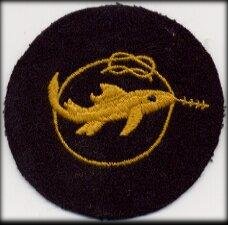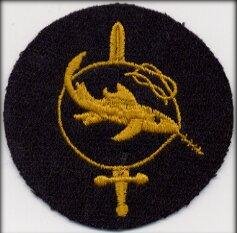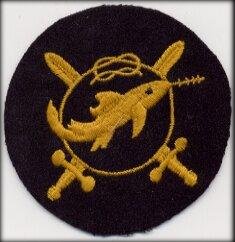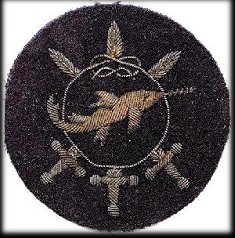
By Gordon Williamson
The K-Verbände, also known as the Small Battle Units, were formed in April 1944 under the command of Konteradmiral
Heye. Probably best know for their use of the small midget submarine types such as Neger, Biber, Molch etc, the K-Verbände also use diverse other weapons systems such as the Sprengboote, small speedboats packed with dynamite and driven directly to their targets.
These were not suicide weapons (though nearly so!) as it was intended that the operator dive overboard at the last possible moment and be picked up by a control boat.
On 30 November 1944 a special range of awards was introduced for the K-Verbände by Grossadmiral Dönitz. The introduction order read as follows.
1) In recognition of the dashing attacks carried out with success by the Kleinkampfverbände, I institute for the soldiers of the
K-Verbände, Bewährungs and Kampfabzeichen in the following form.
The insignia up to the 4th Grade will be worn on the upper right arm level with the position of the Clasp above the ribbon bar. 2) The criteria for the award is general merit and fulfillment of requisite conditions. 3) The insignia is awarded in my name by the commanding admiral of the
K-Verband. Dönitz The awards were designed by Ottfried Neubecker and the first 4 grades consisted of an embroidered sawfish on a blue wool circular patch. Original examples may be encountered in machine embroidered yellow cotton thread, hand embroidered celleon thread, or hand embroidered bullion wire. Mention should also be made of the Probationary level of this award, which consisted of the same Sawfish emblem, but without the circular rope motif in the center. Grade 1 consisted of a sawfish lying over a circle of rope, knotted at its base. This was awarded for some minor act of merit or proficiency such as planning a successful action. Grade 4 had an additional third Sword. Awarded after participation in third action. Grade 5 was a Bronze metal clasp with the Sawfish lying on a horizontal length of intricately knotted rope. Awarded after participation in four major actions. Grade 6 was as for Grade 5 but Silver. Awarded after participation in seven major actions. Grade 7 was as for Grade 6 but Gold. Awarded for participation in ten or more major actions. The metal clasps are not known to have been actually issued, though awards were certainly made "on paper".
|
 1st Class |
 2nd Class |
|
 3rd Class |
|
 4th Class |
The vast majority if not all of those metal clasps in circulation are those produced as part of the 1957 de-Nazified series of awards. Some of these have early wartime type hinges and pins and may be found with a variety of spurious markings (L/56, L/12, L/18 to name but three).
Fortunately there is an easy way to detect these copies. In the only verified original piece yet noted, sold by Hamburg Dealer Detlev Niemann in 1998, it is clear that the fins of the Sawfish are not ribbed, but smooth. This is the original pattern piece from which all others would be copied.
The postwar type has the Sawfish fins lightly ribbed.

In the U-Boot Archiv in Cuxhaven is the postwar Bundesmarine a tunic donated by an officer who had served in the K-Verbände in WW2 as well as the Bundesmarine. On the medal ribbon bar can be seen the miniature metal Kleinkampfmittelverbände clasp. Although the metal clasps seem to have been bestowed on paper, there is no evidence as yet to suggest that any were every actually issued. No award documents seem to have been produced for these awards, though original Soldbücher with entries for the lower grades in cloth are known.

Only a handful of award certificates have been encountered and these are invariably of the
typewritten form, local produced from sheets of plain paper and typical of very late war awards, not the official printed blanks which would be used for most military awards.
![]()
© Copyright Wehrmacht-Awards.com LLC |